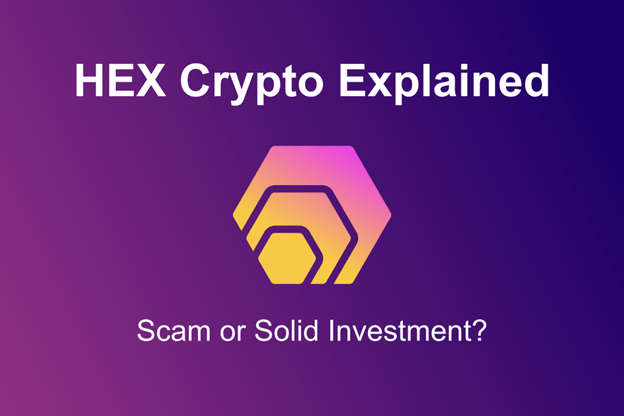
In the vast landscape of cryptocurrencies, some projects capture attention not just for their technology but also for their marketing, promises, and the controversies they spark. One such project is Hex, which has been at the center of debate since its inception. So, what is Hex, how does it function, and what are the arguments surrounding its legitimacy?
What Is HEX?
Hex, established in 2019 by Richard Heart, identifies itself as the inaugural blockchain certificate of deposit (CD). Mirroring traditional bank CDs that offer enhanced interest for maintaining deposits over predetermined periods, Hex enables its holders to stake HEX tokens, pledging to keep them untouched for durations ranging from one to 5,555 days (over 15 years). As a reward for this patience, stakers receive HEX returns at the end of the stipulated period. However, accessing these tokens prematurely incurs substantial penalties.
Despite its relatively short history, Hex has traversed a rocky path, peaking at a market capitalization of $30 billion and plummeting to $860 million as of August 2023. But the story of Hex extends beyond its market performance.
The Mechanism Behind HEX
Central to Hex’s operation is its “proof of wait” system. Unlike conventional cryptocurrencies that reward miners or validators, Hex pays its token holders. When stakers commit to a duration, their HEX tokens are burnt, and they are awarded “T-Shares.” These shares accrue interest daily in HEX. Essentially, the longer the stake duration, the more T-Shares one can amass.
Hex’s structure encourages a long-term holding mindset. It integrates an annual inflation cap of 3.69%. This inflation, coupled with penalties on premature withdrawals, is used to reward patient stakers.
The Genesis of HEX and Its Controversies
Hex made an audacious debut. In its inaugural year, Bitcoin and Ethereum holders could claim Hex tokens at no cost. This phase culminated in the “Big PayDay,” wherein all unclaimed tokens were distributed among existing Hex owners.
Yet, it’s impossible to discuss Hex without addressing the concerns about its legitimacy. Labelled by critics as a potential scam or Ponzi scheme, the skepticism intensified when Heart conceded that Hex employed “tactics a scam might use,” attributing these doubts to inherent loyalty biases within the crypto community.
Comparing HEX and Bitcoin
Hex’s differentiation from Bitcoin is prominent in its technical design and philosophical approach. While Bitcoin employs a proof-of-work mechanism, which is energy-intensive, Hex utilizes its “proof-of-wait” system. Additionally, Hex’s inflation model, directly benefitting its holders, contrasts with Bitcoin’s halving events that reduce mining rewards over time. Moreover, while Bitcoin operates on its dedicated blockchain, Hex rides on the Ethereum network.
The Utility Argument
A primary criticism of Hex is its perceived lack of utility. In an era where even meme coins are striving to find functional use-cases, Hex’s sole premise of being a store of value and its monetization of the “proof-of-wait” concept raised eyebrows. However, its proponents argue that the very act of serving as a store of value, akin to gold, is utility in itself.
Price, Projections, and Purchase
As of August 2023, HEX’s valuation rested at $0.005. Predictions regarding its future price trajectory diverged, from bullish optimism to cautious reservations.
For those wanting to buy HEX, a variety of acquisition methods are available:
Centralized Exchanges (CEXes): These platforms, like BitGet for example, offer a structured and user-friendly interface. They often have less price volatility than DEXes and provide dedicated customer support.
Decentralized Exchanges (DEXes): Platforms such as Uniswap typify this category. They may have less intuitive interfaces, greater price fluctuations, and typically lack centralized customer support. However, they offer a more direct and decentralized trading experience.
Fiat On-Ramp Platforms: Services like Guardarian facilitate the direct purchase of HEX using traditional fiat currencies, easing the entry for those new to the crypto world.
Whichever method one chooses, it’s essential to be aware of the unique advantages and challenges each platform presents.
Concluding Thoughts
Hex’s journey has been a testament to the unpredictability and dynamism of the cryptocurrency space. Its audacious promises of high returns and its unique approach have garnered both ardent supporters and stern skeptics. While some view Hex as the future of DeFi and an evolution of the traditional banking system, others see red flags suggestive of unsustainable mechanisms.
Like all investments, potential Hex investors should tread with caution. Beyond the allure of high returns, it’s vital to understand the project deeply, recognizing the inherent risks. After all, in the volatile world of cryptocurrencies, the balance between reward and risk remains delicate.


































